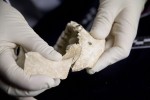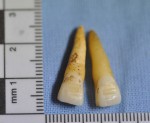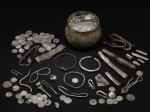 The remains of around 50 decapitated Vikings unearthed in 2009 during the construction of the Weymouth Relief Road in Dorset on the southern coast of England were not the elite fighting force sung about in the sagas. They weren’t even garden variety Viking raiders. Researchers have found no evidence of previous fighting injuries which means if they were in England to raid, they were novices at it.
The remains of around 50 decapitated Vikings unearthed in 2009 during the construction of the Weymouth Relief Road in Dorset on the southern coast of England were not the elite fighting force sung about in the sagas. They weren’t even garden variety Viking raiders. Researchers have found no evidence of previous fighting injuries which means if they were in England to raid, they were novices at it.
 The early forensic examination of the remains pointed to this being a Viking raiding party who met a grisly end at Anglo-Saxon hands. The skeletons were all male, seemingly in good physical condition. Stable isotope analysis of their teeth confirmed their Scandinavian origin. They all spent their early childhoods in the Arctic and sub-Arctic areas of Norway, Sweden, Finland, the Baltic States, Belarus and Russia. The bodies were on one side of the pit while the heads were
The early forensic examination of the remains pointed to this being a Viking raiding party who met a grisly end at Anglo-Saxon hands. The skeletons were all male, seemingly in good physical condition. Stable isotope analysis of their teeth confirmed their Scandinavian origin. They all spent their early childhoods in the Arctic and sub-Arctic areas of Norway, Sweden, Finland, the Baltic States, Belarus and Russia. The bodies were on one side of the pit while the heads were stacked on the other side. Defensive wounds were found on hands and arms, but the fatal wounds were on the necks, skulls and shoulders. These were not clean decapitations. The heads were cut off in several sword blows from the front. There were no artifacts interred with them, not even any clothes, suggesting they were stripped before or after death.
stacked on the other side. Defensive wounds were found on hands and arms, but the fatal wounds were on the necks, skulls and shoulders. These were not clean decapitations. The heads were cut off in several sword blows from the front. There were no artifacts interred with them, not even any clothes, suggesting they were stripped before or after death.
 Further osteological analysis found that the skeletons dated to 970-1025 A.D during the reign of Æthelred the Unready or Cnut the Great. Almost all of the men were between 18 and 25 years old. There were outliers, though: one youth in his early or mid teens, and one senior who was over 50 years old at the time of death. Several of the men had filed teeth, a Scandinavian practice of unknown symbolism that may have been an indicator of social status, specific occupation or a way to make the battle grimace scarier by filling in the dental grooves with paint.
Further osteological analysis found that the skeletons dated to 970-1025 A.D during the reign of Æthelred the Unready or Cnut the Great. Almost all of the men were between 18 and 25 years old. There were outliers, though: one youth in his early or mid teens, and one senior who was over 50 years old at the time of death. Several of the men had filed teeth, a Scandinavian practice of unknown symbolism that may have been an indicator of social status, specific occupation or a way to make the battle grimace scarier by filling in the dental grooves with paint.
 It was the physical condition of many of the remains that exploded the early theory that they might have been the mighty mercenary Jomsvikings or imitators thereof. The remains testified to a number of chronic illnesses and injuries that would have been seriously debilitating. One man’s thigh bone has two deep holes in it from the chronic bone infection osteomyelitis. Louise Loe of Oxford Archaeology describes it deliciously grossly:
It was the physical condition of many of the remains that exploded the early theory that they might have been the mighty mercenary Jomsvikings or imitators thereof. The remains testified to a number of chronic illnesses and injuries that would have been seriously debilitating. One man’s thigh bone has two deep holes in it from the chronic bone infection osteomyelitis. Louise Loe of Oxford Archaeology describes it deliciously grossly:
“The bone was twice the size of a normal thigh bone and had openings which would have oozed smelly pus during his life. The leg would have been swollen and painful. It must have posed a considerable disability to the individual, and consequently the rest of the group.”
 Another raider had a healed fracture to his right femur that left his right leg significantly shorter than his left. A kidney or bladder stone was found among the skeletal remains. Some of the men had what researchers think is brucellosis, an infectious disease transmitted from unpasteurized milk or other close contact with the secretions of infected animals. It causes joint and muscular pain and at its worst, can result in arthritis, meningitis and neurological disorders.
Another raider had a healed fracture to his right femur that left his right leg significantly shorter than his left. A kidney or bladder stone was found among the skeletal remains. Some of the men had what researchers think is brucellosis, an infectious disease transmitted from unpasteurized milk or other close contact with the secretions of infected animals. It causes joint and muscular pain and at its worst, can result in arthritis, meningitis and neurological disorders.
Some of these remains, including the suppurating thigh bone, are now on display at the British Museum’s Vikings: Life and Legend exhibition. Although the British Museum was already well into the planning of the show when the Weymouth pit was discovered, they immediately moved things around so there would be room in the display for the decapitated raiders. The exhibition runs from March 6th to June 22nd and will include among its many treasures the first public display of the entire Vale of York Hoard.
among its many treasures the first public display of the entire Vale of York Hoard.
In September, the Dorset skeletons will travel to the Museum of Prehistory and Early History in Berlin. In January of 2015 they will return to England where they will find a permanent home in the new Ancient Dorset gallery of the Dorset County Museum. There they will be displayed in their original positions in a reconstructed version of the burial pit.
Was this really just a late ‘Viking raiding party’, or was it possibly part of a bigger game ? The ‘Anglo-Saxons’ were definitely ‘settled’ by then, but there was also the ‘Danelaw’ and certain other ‘danish’, ‘norse’ or ‘norman’ settlements and strongholds (i.e. before 1066) within a more -or by then possibly less- ‘unified’ English kingdom. In other words: Could this have been part of the ‘process of unification’, maybe similar to what can be witnessed currently in Eastern Europe ?
It could be, certainly, but the fact that they’re all male suggests a fighting party of some kind rather than settlers. Also, many of their shoulder joints were larger than their hip joints, which means they were very experienced oarsmen and most likely came to England from the sea rather than the Danelaw.
My question is in regard to the skeletal remains: isn’t there a law in Great Britain that requires any human remains to interred respectfully? Will the actual remains be on display or facsimiles?
There is a law, or rather a regulatory interpretation of a law, that in theory requires burial within two years. I don’t know why that doesn’t seem to have happened here, but I’ve sent an email to find out.
The info about the Viking who suffered from osteomyelitis, and the bone photo were particularly interesting to me. My father contracted the disease after falling and injuring his shin bone as a young boy. He was born in 1904, in Holland, then came to the U.S. with his family in 1912. I never knew whether the injury had been sustained there, or after they came here. By the time I, and my siblings came along (in the 40’s), the disease had traveled from his leg to his upper arm, where he had an open wound that my mother cleaned and dressed every night. It never stopped him from leading a normal life. Before he met my mother, he used to race Indian motorcycles. He worked over 50 years on the railroad as a track laborer, then foreman. I never heard him complain once about pain, and he never missed a day of work. He was up every day at 5, and was out in all kinds of weather, making sure the tracks were clear for the trains. He lived to be 72, and In the end, it wasn’t the osteomyelitis that killed him, but lung cancer.
I was p excited to read about the decapitations because my first thought was :ohnoes: viking vampires!
If only they had been cat-faced…
When you look closely at the ground where the skulls are stacked up, there seem to be some stacked up bricks. Where the bodies thrown into some kind of structure?
I’m a bit confused. Were the Skeltons :skull: and all that booty found togather? If the locals caught them and gave then the chop,why didn’t they keep all that money?
There was no booty at all found in the mass grave. Not even any personal belongings or evidence of clothing.
Countess, reread the next to the last paragraph, and perhaps that will clarify things for you. I read it to mean that the exhibition, to include the previously discussed “Vale of Yale” hoard, had already been planned, but the curators rearranced things so that the newly uncovered hapless Viking skeletons could be included.
Looks like ordinary fractured sed rock layers to me. Lots of that here in New England where I live. Devil to dig a pit in.
Thank you Annie.Your right It was late and I recon I just missed it :blush: .Now it makes way more sense. :yes:
No Danes, I notice.
That explains it…